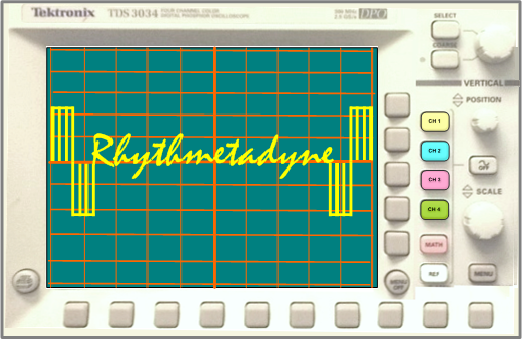RhythMetaDyne Technology
Creating a Safer EM Environment
As engineers with real-world experience designing and building wireless and digital electronics, we know how useless passive patches and holographic stickers are in doing anything to prevent damage to our bodies from ElectroMagnetic Radiation (EMR). In order to combat EMR we need an active solution, something to interrupt and counteract the signals causing this damage. This required a lot of research and we uncovered some amazing discoveries in the process.
One of the problems encountered is the absence of any consensus on how EMR affects human physiology. It turns out there are two parts to the problem. The first has to do with how EMR affects the body in non-obvious ways (other than electrocution or ionizing microwaves that can boil the water in our bodies). The second part has to do with why engineers have largely ignored the health concerns of EMR.
How EMR Affects our Bodies
Dr. Franz Halberg, who coined the term Circadian Rhythm in the 1950’s, found strong EM fields could interfere with our body’s internal clock. Dr. Halberg discovered this internal clock not only regulates our sleep cycles, it also governs the production of proteins we need for healing and growth. In the 1950’s there was relatively little EM pollution and the problem was largely ignored. Fast-forward 60 years and now we live in a virtual sea of EM Radiation and Pollution with the plethora of electronics and wireless devices we carry and use daily.
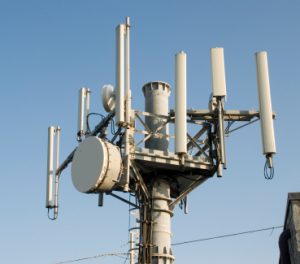 Wireless Communications Tower – Common Source of EMR
Wireless Communications Tower – Common Source of EMR
While the debate continues as to whether wireless devices can cause cancer or other health problems, we now know wireless signals can interfere with our body’s internal clock and disrupt our physiology. This interference may prevent us from producing the proteins necessary to fight the aberrant cells before they mutate into cancer or other illnesses.
Why Engineers have Ignored EMR
Electromedicine, using electrical currents and frequencies were the accepted method to actually cure disease and illness 100 years ago. Unfortunately, when the pharmaceutical industry backed Flexner Report was published in 1910 it challenged doctors to explain how Electromedicine worked. Doctors then and today don’t receive training in electrical engineering, and engineers likewise don’t receive training in human physiology. To further complicate matters, doctors use Latin and engineers use Greek, so neither group could fully explain how Electromedicine healed the body. As a result, it was called quackery and fell out use by the 1940’s.
When weak electrical current and frequencies were no longer deemed helpful, it followed they couldn’t be harmful. As a result, these were considered harmless. Engineers who didn’t worry about these ‘harmless’ aspects began designing new systems without regard to their potential effects that could cause injury and focused on reducing costs and increasing reliability, admirable goals, but ones counter to Electromedicine’s history of healing.
One of the biggest problems with cellular communications isn’t the very high frequency carrier signals, (unless you’re standing next to cellular tower’s antennas) but rather the interval (or frequency) which the carrier hops from one frequency to another. It’s this frequency hopping that interferes with audio equipment and disrupts our internal clock. The problem could be corrected by changing the hopping interval to use ‘healthy’ frequencies,but this would require a complete swap-out of all the cellular infrastructure and mobile phones. That’s not going to happen soon, so we had to find a way to counteract this and all the other sources of EMR that are disrupting our bodies’ biological processes.
Rhythmetadyne to Combat EMR
Our first concerns were how to protect people in their homes from the risks of EMR from high power lines and nearby wireless towers. We considered wrapping the house with a wire coil, but that was impractical. Our next thought was to protect people while they slept, as nearly half the time most persons are at home, they are in bed. If we are in bed 8 hours a day (that would be nice, huh?) then we could at least protect people for a third of their life, which was a good start.
This line of reasoning led to the development of our sleep product called Somnius, which has proven to be over 95% effective in helping people sleep. And it substantiated our research with regard to our bodies being sensitive to EMR. Somnius produces precise EM pulses derived from a Fibonacci crystal that cause brainwave entrainment emulating classic Circadian Rhythm sleep patterns as observed in sleep studies of healthy individuals. Somnius is a 2 1/2 inch by 2 1/2 inch USB powered Sleep instrument used under your pillow – mitigates EMR while helping you sleep.
Solving the problem while you slept was a good start, but we still wanted a way to protect the entire home. We reasoned that If part of the problem in homes comes from the wiring in the walls, then could we use that same wiring as a part of the solution? The answer was, “YES!” And not only did this solve the problem of counteracting EMR from the AC wiring itself, it also turned the home’s wiring into a protective grid that shielded the occupants from EMR outside the home.
But we weren’t done improving the design. We realized we needed to protect people at work and in their vehicles as well as at home. And we wanted the same product to work in all these places.
Migrating to USB
Another breakthrough opened an entirely new way to look at how to combat EMR anywhere it was present. It turned out USB ports were becoming standard on nearly every piece of electronics. USB power connectors were being added to vehicles and were already on every computer and laptop in use. We decided to leverage the growing number of USB power adapters being used and migrated our design to this new platform.
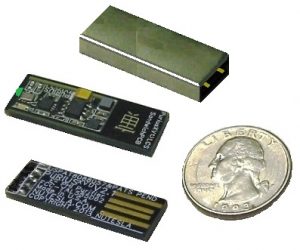 Our third generation Rhythmetadyne prototype for direct USB connection
Our third generation Rhythmetadyne prototype for direct USB connection
Here’s the bottom side of the PCB showing the components. There is another PCB attached to the bottom that protects the components and provides the right sizing for the USB connector. This sandwiched design keeps manufacturing and material costs lower.
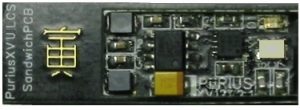 Third generation Purius prototype for USB showing component side
Third generation Purius prototype for USB showing component side
The symbol on the left side is the ancient Chinese astrology symbol for the Tiger and Respect and is used on all the circuit boards I design and layout. As you can see the number of components is minimal, as the bulk of engineering is in firmware, which keeps production costs lower still.
This version of Rhythmetadyne uses a kind of electrical sonar to transmit a signal into the host environment and then measure the return and uses that to determine the optimum clearing signal. And Rhythmetadyne can transmit and measure over a hundred combinations in less than one second, so there is no noticeable delay when its plugged into the USB receptacle. The oscilloscope image below shows one of the possible modulation types using two different carrier frequencies on one side of the USB power circuit.
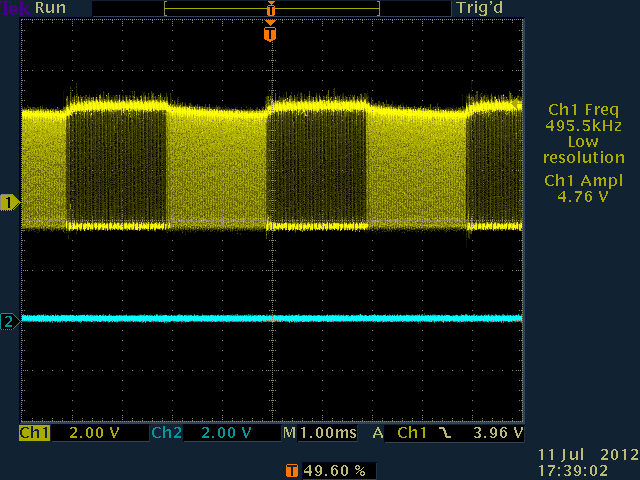 New Modulation Scheme with two alternating carrier frequencies being emitted on USV +5V connection, captured on digital oscilloscope
New Modulation Scheme with two alternating carrier frequencies being emitted on USV +5V connection, captured on digital oscilloscope
Testing Rhythmetadyne has proceeded smoothly and we’re ready to move to the next project phases of developing the host computer software to manage and update Rhythmetadyne products as future improvements are discovered and to finalize the design for mass production.
Rhythmetadyne uses electromagnetic spectroscopy to make it extensible in any environment.
Rhythmetadyne is an elegant USB based solution to the problem of EMR pollution because it leverages the actual polluters themselves, turning unhealthy wiring into healthy emitters of Circadian Rhythm restoring Bio-Pulses.
Rhythmetadyne is Effective EMR Protection
Rhythmetadyne is an active EMR protection device that simply plugs into any powered USB A receptacle and transmits an AM band signal that doesn’t interfere with its host system and uses the wiring of the host to send healthy signals, overcoming the inherent unhealthiness of its host system. Rhythmetadyne uses a combination of Rife, Schumann and Solfeggio frequencies to restore natural Circadian rhythms.
Rhythmetadyne is Low Cost
Rhythmetadyne is software intensive and as a result, the hardware is remarkably simple, which keeps production costs to a minimum. This is critical because we recognize the marketplace is flooded with worthless, inexpensive passive EMR so-called ‘protection patches’ that we’ve proven in our lab do nothing but help waste your money. Our goal has been to create an active and effective EMR protection instrument that can retail for under US$50, and we’ve done it.
Rhythmetadyne is Simple to Use
Not only is Rhythmetadyne inexpensive, its also simple to use. All the user has to do is plug it into an powered USB receptacle, like the ones on your computer, or cell phone charger, and it scans the electrical
environment to determine the optimum frequency and modulation type.
Rhythmetadyne Will Never Go Out-of-Date
Just as important as being simple, Rhythmetadyne is fully USB 2.0 compatible and enumerates as a universal HID product when plugged into a host computer. Software for Windows has already been developed to control
and update PüriusXV, and development is scheduled for Mac OS and Linux so you can be assured it will never go out-of-date.
Rhythmetadyne is a Platform To Do More
Rhythmetadyne is a hardware platform for other purposes as well, including signal scrambling, preventing eavesdropping and attempts at EM mind control. You can even use PüriusXV and your computer to measure your Critical Flicker Fusion frequency to track your health and increase your mind’s processing ability to achieve quantum level thinking.
Rhythmetadyne can be Used Anywhere
Since Rhythmetadyne uses USB for its power and connection, it can be used anywhere in the world. We have self-certified it through our own lab and testing so it meets all the FDA, FCC and EC requirements. It has no import/export restrictions or licensing requirements.
Rhythmetadyne is Made in America
While Rhythmetadyne can be manufactured on any continent, we’ve found the manufacturing quality to be highest right here at home in the U.S. and we’ve designed Rhythmetadyne to be lower in cost so it can continue to be the highest possible quality product.
